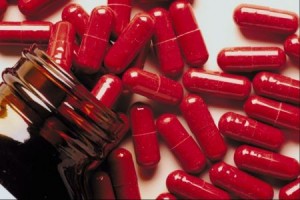 Are Antioxidants Useful for Preventing Muscle Wasting?
Are Antioxidants Useful for Preventing Muscle Wasting?
Increases in muscle mass result from increased size of the pre-existing muscle fibers due to accumulation of new muscle proteins. By contrast, skeletal muscle atrophy or muscle loss is associated with decreased content of contractile proteins. In other words, skeletal muscle mass is directly proportional to the protein content, which ultimately depends on the balance between synthesis and degradation.
Hormones such as insulin, growth hormone, and IGF-1 reduce protein degradation rates, in addition to stimulating the rates of synthesis. Moreover, insulin administration to rats with tumors and to cancer patients has been shown to reverse the muscle-wasting pattern and the increase in protein breakdown.1-3 By contrast, glucocorticoids (cortisol) exert a clear catabolic effect, and their levels are frequently increased in diseased states. Cortisol activates a catabolic enzyme called ubiquitin-proteasome, which breaks down muscle tissue. Acute glucocorticoid treatment increases the expression of ubiquitin-proteases in muscle, resulting in catabolism.
Preventing muscle breakdown or muscle atrophy can be accomplished by preventing hormones (cortisol) or other immunological mediators (inflammatory cytokines) that impinge on muscle protein metabolism, thereby altering the physiological balance between synthesis and breakdown— favoring the latter and possibly reducing the former— resulting in protein breakdown. In addition to hormones such as cortisol that break down muscle, reactions such as oxidative stress can reduce muscle protein synthesis. Oxidative stress has been proposed to be involved in the pathogenesis of skeletal muscle wasting in multifaceted ways, including increased protein breakdown.
Oxidative stress is caused by an imbalance between the production of reactive oxygen and the body’s ability to readily detoxify the reactive intermediates, or easily repair the resulting damage. Free radicals are produced every day in your body; the key is to minimize the damage they can do to your cells. Your body constantly reacts with oxygen as you breathe, and your cells produce energy. As a consequence of this activity, highly reactive molecules known as free radicals are produced. When you are breathing hard from your last set of squats, you are producing free radicals— but don’t be so concerned about that because there is nothing you can do about it.
Be more concerned with dietary and environmental causes of free radicals such as pollution, smoking, high-fat meals, low fruit and vegetable consumption, and heavy metals found in water. In humans, excess oxidative stress is linked to many diseases, such as atherosclerosis, Parkinson’s disease, heart failure, myocardial infarction, Alzheimer’s disease, and chronic fatigue syndrome— but short-term oxidative stress may also be important to prevent aging.
Oxidative Stress and Muscle
So what happens when your muscles are exposed to excess free radicals or reactive oxygen species (ROS)? Does taking an antioxidant like mixed tocopherols, CoQ10 or lipoic acid help to build muscle and prevent muscle loss with age?
It has been demonstrated that the level of ROS that’s produced influences skeletal muscle force production. For example, excess muscle ROS concentrations result in inhibition of muscle contraction.5 ROS are also involved in generating muscle fatigue during repeated or sustained contractions.6 Oxidative stress has also been suggested to drive muscle protein hypercatabolism and muscle breakdown, contributing to skeletal muscle dysfunction. In this regard, ROS are involved in the activation of the catabolic proteolytic pathway, by breaking muscle proteins.7-9
Antioxidants and Muscle Anabolism
This is where antioxidants come to the rescue for muscle. Antioxidant defenses are rapidly induced by cells to cope with oxidative stress. Deficiency or depletion of various antioxidant systems has been consistently shown to exacerbate oxidative tissue injury. As for the skeletal muscle, fiber type significantly affects antioxidant enzyme activity, which is greater in slow-twitch oxidative fibers than in fast-twitch glycolytic fibers.9
ROS production has been shown to increase skeletal muscle during aging,10 and oxidative stress has been claimed to be relevant to age-related cell damage. In this regard, aged skeletal muscle is less prone to activate the regenerative response after injury. This is related to a reduction of anabolic signal transduction pathways such as those regulated by IGF-1, and because the ROS hinder IGF-1’s ability to activate satellite cells— impairing their ability to repair muscle. Thus, the increased oxidative stress in aging could result in impaired muscle cell protection and more muscle cell damage— and overwhelm the body’s ability to repair.
In addition to damage occurring directly at the skeletal muscle level from excess ROS with aging, sarcopenia— loss of muscle mass in aged individuals— is associated with reduced antioxidant dietary intake.11 Poor muscle strength and low physical performance have been associated with low levels of circulating carotenoids.12,13 Indeed, at least some of the mechanisms involved in muscle depletion, such as enhanced proteolysis or reduced protein synthesis, may also depend on increased oxidative damage to muscle— supporting the adoption of antioxidant therapeutic regimens. However, despite the observation that oxidative stress generally occurs in the atrophying muscle, irrespective of the causative mechanisms, the extent of its contribution to tissue wasting is unclear.14
In some cases, a strong contribution of redox imbalance to the pathogenesis of muscle depletion can be recognized, and even inferred, from the effectiveness of antioxidant therapy. This is particularly evident in diabetes, in which antioxidants such as vitamins C and E and resveratrol have been shown to significantly protect from muscle wasting. In other cases, the results obtained with antioxidant treatment are contrasting, although some studies demonstrated a degree of protection against muscle atrophy in cancer cachexia, Duchenne muscular dystrophy, aging and ALS.15 In all these conditions, oxidative stress probably behaves as an additional factor that amplifies the wasting stimuli, but does not play a leading role.
The practical applications of this article are that taking antioxidants such as resveratrol, green tea, and curcumin are not going to result in immediate or noticeable gains in strength and size, but they will slow the damage to muscle that takes place over years. If you are looking for a long-term insurance policy for maintaining muscle as you age, taking antioxidants is going to prevent free radical damage to muscle and maintain a more anabolic state in your muscles.
source:musculardevelopment.com
